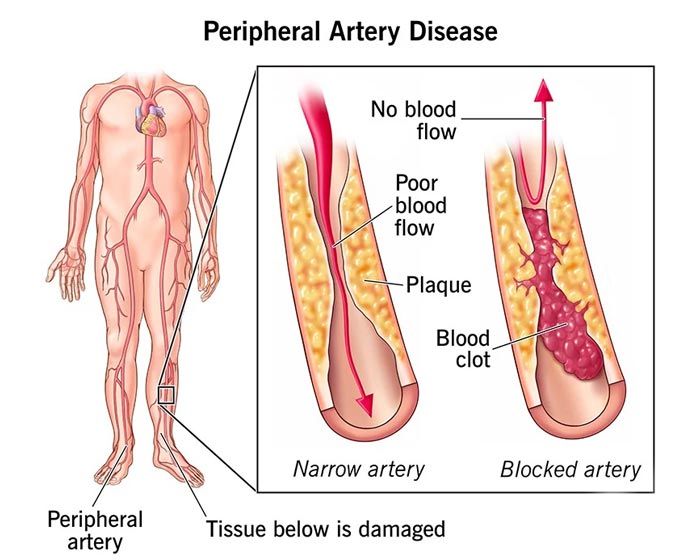
Peripheral Artery Disease (PAD) is a condition where the arteries in your legs become narrowed or blocked, limiting blood flow. Early detection of PAD is vital for managing the disease and preventing complications. Understanding the symptoms and knowing what to look for can make a big difference. Here’s a guide to help you spot PAD early and understand the symptoms you should never ignore.
What is Peripheral Artery Disease?
Peripheral Artery Disease (PAD) occurs when the arteries that supply blood to your legs and feet become narrowed or blocked due to fatty deposits. This reduced blood flow can lead to various symptoms and complications if not addressed promptly. For a detailed explanation of PAD, you might want to consult a peripheral artery disease specialist who can provide a thorough understanding of the condition and its effects.
Key Symptoms of Peripheral Artery Disease
1: Pain in the Legs and Feet
One of the most common symptoms of PAD is pain in your legs or feet, especially during physical activities like walking or climbing stairs. This pain is often described as cramping, aching, or discomfort. It usually goes away with rest, but if you notice this pain occurring frequently or without physical exertion, it could be a sign of PAD. For a comprehensive assessment, visiting a peripheral artery disease doctor can help confirm if your symptoms are related to this condition.
2: Leg Weakness or Numbness
If you experience weakness or numbness in your legs, it might be a symptom of PAD. This weakness can make walking or standing difficult and may make you feel unsteady. Numbness in your legs or feet can also affect your balance and coordination. If these symptoms are affecting your daily life, it’s important to get an evaluation from a healthcare provider familiar with PAD treatment.
3: Coldness in the Lower Extremities
PAD can cause one leg or foot to feel colder than the other. You might notice that your feet or legs feel unusually cold to the touch. This cold sensation can be more pronounced when compared to the warmth of the rest of your body and is a sign that blood flow is restricted. For proper diagnosis and management, consider visiting a clinic specializing in PAD.
4: Change in Color of the Legs
Pay attention to any changes in the color of your legs. Healthy skin typically has a consistent color, but with PAD, you may notice that your legs turn pale, bluish, or reddish. These color changes can be an indication of poor blood circulation and should be checked by a peripheral artery disease specialist.
5: Non-Healing Wounds or Sores
People with PAD often experience wounds or sores on their legs or feet that take a long time to heal. If you have any cuts, bruises, or sores that aren’t healing properly, it could be a sign of inadequate blood flow to the affected area. Effective peripheral artery disease treatment can help improve healing and manage symptoms.
6: Reduced Pulse in the Legs
A reduced or weak pulse in your legs can be an indicator of PAD. To check your pulse, gently press your fingers on the inside of your ankle or behind your knee. If you can’t feel a pulse or it feels weak, it’s important to consult a healthcare professional. Peripheral artery disease doctors can perform tests to assess your circulation and provide appropriate treatment options.
Risk Factors for Peripheral Artery Disease
Certain factors increase the risk of developing PAD. These include:
- Smoking: Tobacco use damages blood vessels and decreases blood flow.
- Diabetes: High blood sugar levels might harm the blood vessels and nerves..
- High Blood Pressure: This can contribute to the narrowing of arteries.
- High Cholesterol: Excess cholesterol can lead to fatty deposits in the arteries.
- Age: Risk rises with age, particularly beyond 50.
- Family History: A family history of PAD or cardiovascular disease may raise your risk.
When to Seek Medical Attention
If you notice any of the symptoms mentioned above, it’s important to seek medical advice promptly. Early detection and treatment can help manage PAD effectively and reduce the risk of serious complications such as ulcers, infections, or even limb loss. For more information on managing your symptoms, Midas Care Clinic provides expert care and treatment options for those dealing with PAD.
Conclusion
Being aware of the symptoms of Peripheral Artery Disease is essential for early detection and effective management. Pain in your legs, weakness, coldness, color changes, non-healing wounds, and reduced pulses are key indicators you should watch for. By understanding these symptoms and recognizing them early, you can take proactive steps to maintain your health and seek appropriate medical care.

